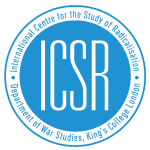The full Review of Evidence can be accessed here.
Please read on for the Summary.
Background
Despite the importance of prisons to terrorist movements and the surge in the jihadist prison population in the Middle East, relatively little is understood about how the prison environment influences terrorists to become violent or peaceful. Prisons have been “centres of gravity” for virtually every terrorist group in the modern era. The strategies, goals, and operations of a variety of groups – from Egyptian Islamists to German Marxists and Irish Republicans – have all been heavily influenced by the imprisonment of their members. In many instances, the treatment of imprisoned comrades served as an important rallying cause, and the lives of extremists have been fundamentally shaped by their time in the jail cells of the state. The increase in the number of suspected and convicted terrorist inmates throughout the Middle East, particularly in Iraq and north-eastern Syria, has made prisons even greater focal points in countering Salafi-Jihadi movements. It is vitally important to continue to tailor policy according to the best available evidence in various contexts and to understand the dynamics and consequences of different types of prison management.
Aims
The aim of this rapid review of evidence (RoE) is to identify which interventions have been most effective in managing and rehabilitating violent extremists across the world. Its purpose is to help inform current and future FCDO policy debates about prison-related interventions for convicted or suspected violent extremists.
Methods
This review examines 34 studies (including academic articles, policy reports, programme evaluations, and the grey literature) published in English between 2000 and 2021. The systematic search generated 9,447 articles, of which 25 met the inclusion criteria. The hand search identified an additional nine studies for inclusion.
Key Findings
The evidence base for prison-based interventions targeting violent extremists, whether in fragile and conflict-affected states or in the developed world, is very poor. Many existing programmes are in their infancy, and so they have not yet been robustly evaluated. However, there are promising themes. The naming of programmes can affect attitudes towards them, whether of participants or wider society. Involving family members can be beneficial to participants, and relatives can be supportive of deradicalisation/disengagement measures. Using deradicalised/disengaged leaders of extremist groups in interventions can have a positive impact on low-level members. There are promising signs that rapport-building is an effective technique when interviewing terrorist detainees. The same is true of motivational interviewing (MI), especially when applied to detainees who are ambivalent about and resistant to change. These techniques encourage engagement and disclosure of information. There is also some evidence that conducting sessions in informal settings leads to greater engagement. Regarding wholesale programmes, the most effective programmes are ones with a comprehensive array of interventions, which include treating inmates with dignity and respect. The Sri Lankan programme has been most effective, and there are promising aspects of the Saudi Arabian and Pakistani initiatives. Those programmes are comprehensive and multifaceted in approach, including vocational training, psychological support, family support, religious counselling and education, and, in some cases, financial assistance.
Limitations and Gaps
There are severe limitations to the existing evidence base. While the gold standard in scientific research is a randomised controlled trial with a large, double-blind sample, it is not possible to research counterterrorism practices in this manner. Given that the subject is highly sensitive (as it involves issues of national security), the field is beset by opaque and limited data. It is rare for authorities to grant access to independent, external researchers, who would then scrutinise and publicly report on what they encountered. This is especially the case regarding prison-based interventions targeting violent extremist detainees, which involve heightened sensitives and often occur in authoritarian states where criticism of state practices is suppressed. Negative past experiences with evaluations can also deter authorities from permitting future evaluations. Interventions are often implemented due to necessity and urgency (rather than because they are the result of a double-blind pilot programme) and do not have an explicit Theory of Change. These difficulties mean it is exceptionally rare to find a systematic study on counterterrorism practices, and none of the studies examined here meet the gold standard of scientific research. Instead, the gold standard of research within counterterrorism would involve extensive qualitative interviews with a large sample of practitioners and participants, with a substantial period (>5 years) of post-intervention follow up. Yet this is also rarely achieved in the field. Even when a successful intervention can be identified, it may not necessarily be viable in other contexts. For instance, while Sri Lanka’s programme aimed at LTTE detainees has good evidence of its success, its interventions took place following the abject military loss of the LTTE, meaning there was no armed movement for detainees to return to post-release. The lessons from that programme, therefore, will not perfectly apply to jihadist detainees in Syria and Iraq, where there remains an active insurgency by Islamic State and other groups.
The weak evidence base has implications for HMG and FCDO policy regarding prisons and violent extremism. Numerous and important evidence gaps remain. There is no evidence as to whether civil society organisations (CSOs) are more effective than governments at delivering interventions. There is no evidence as to what interventions offer the best Value for Money, what the minimum or maximum durations should be, or whether participation should be compulsory or voluntary. There is limited evidence of the effect of different placement regimes (i.e. placing extremists together or separating them), and almost no research has focused on interventions aimed at women. Moreover, risk assessment tools for violent extremism are relatively new and have not been validated. It is unknown whether treating trauma would reduce the risk for violent extremism. Finally, there are no proven, reliable means of assessing whether a participant is hiding their true intentions and concealing their extremist beliefs.
Key Recommendations
Given the dearth of a reliable and robust evidence base, a priority should be to develop further the evidence of “what works”. Beyond that, existing HMG and FCDO programmes and policies relevant to prison-related violent extremism should, where relevant: encourage elements of motivational interviewing (MI); conduct interventions in a transparent manner to participants; involve some form of religious counselling and guidance; include educational and vocational training; and, where appropriate, engage with detainees’ families.
Conclusion
Overall, the evidence base for “what works” for prison interventions targeting violent extremism is weak. Determining causality is challenging. Future research is needed to build upon the most promising interventions, to identify nuances and understand the complexities involved. It is necessary to clarify when successful interventions work, when they are at their most effective, and what compounding effects may exist.

This publication was produced as part of the XCEPT programme, a programme funded by UK Aid from the UK government. The views expressed do not necessarily reflect the UK government’s official policies.

